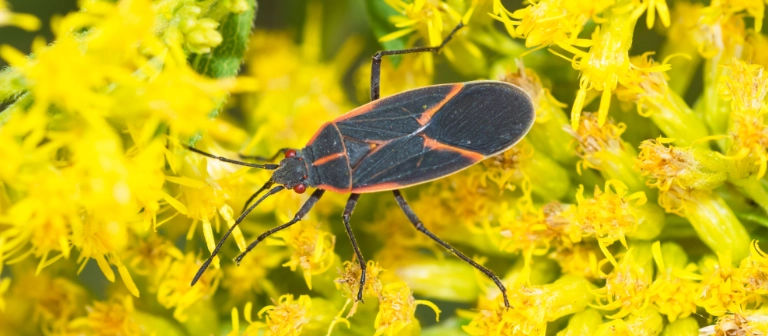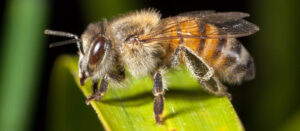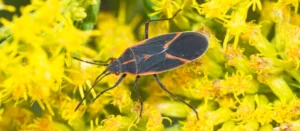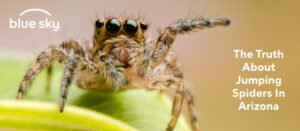$50 OFF New Residential Customers. Learn more
Red & Black Intruders: Meet Arizona’s Boxelder Bugs

Boxelder Bugs in Arizona
If you’ve ever stepped outside and spotted a cluster of black-and-red bugs crawling on your porch or siding, you’re not alone…and you’re not necessarily looking at just one kind of insect. Arizona is home to several red-and-black plant bugs that look nearly identical at first glance. Among them, the western boxelder bug stands out as a particularly common culprit. Keep reading to learn what draws them in and how to keep them out. If you need pest control in the Phoenix area, we can help you. From our offices in Gilbert and Phoenix, we serve the entire metro area including Mesa, Tempe, Avondale, and Peoria. Contact us to get your free quote!
What Are They?
Boxelder bugs and their lookalikes are plant-feeding insects known for congregating in large numbers, especially during certain seasons. While they’re generally harmless, their tendency to gather in large groups can make them a big nuisance for homeowners.
How to Identify Them
Boxelder bugs are distinctive insects identifiable by their unique coloration and markings. Adults measure about half an inch in length and have elongated, somewhat flattened bodies. Their coloration is primarily black, accented with reddish or orange markings. Notably, they display three stripes right behind the head on the prothorax. When at rest, their wings lay flat over their bodies, overlapping to form an ‘X’ pattern.
Immature boxelder bugs, known as nymphs, look quite a bit different from adults. Upon hatching, nymphs are bright red and lack wings. As they mature, they develop black markings and wing pads, gradually resembling the adults. This transformation can lead to confusion with other red and black insects.
Are They Dangerous?
Boxelder bugs and their lookalikes aren’t considered dangerous to either humans or pets. They don’t bite, sting, or transmit diseases. However, if pets, especially cats, ingest these bugs, they could experience mild digestive discomfort. This could show up in the form of drooling or vomiting due to the bugs’ unpleasant taste.
What Damage Can They Cause?
As obnoxious as they are, boxelder bugs don’t really cause too much damage. When these insects congregate in large numbers on trees, their feeding can cause minor damage to leaves, leading to discoloration. However, this is typically cosmetic and doesn’t significantly harm the overall health of the tree.
In agricultural settings, their feeding can result in dimples, scars, and deformities on fruits such as pears, apples, and stone fruits. In some cases, their activity may lead to premature fruit drop, impacting yield. While not as destructive as some other agricultural pests, their presence can still be a concern for farmers.
Indoors, they don’t cause structural damage, but they can become a total nuisance. When they enter homes seeking warmth, their excrement can stain walls, curtains, and furniture. Additionally, if crushed, they emit an unpleasant odor and can leave difficult-to-remove stains.
When and Where You’ll Typically See Them
Boxelder bugs are most noticeable during the fall months. As temperatures drop, they congregate on the sunny sides of buildings, looking for warmth. They often find their way indoors through small cracks and crevices. In the spring, as the weather warms, boxelder bugs come out from their hiding spots and head back outdoors to feed and reproduce, primarily on boxelder and other maple trees. Throughout the summer, you’ll see them on trees, feeding on seeds and new leaves. Their activity peaks during warm months, making them a common sight in yards and gardens. Inside your home, boxelder bugs seek out warm, secluded areas to hide out for the winter. Common hiding spots include attics, basements, wall voids, and storage areas. They may also gather around windows and light fixtures, especially on sunny days when they become more active.
Other Black and Red Bugs in Arizona
While boxelder bugs are the most commonly recognized black and red insects in Arizona, several other species share very similar appearances and behaviors. This leads to frequent misidentification.
Here are some look-alikes:
- Red-shouldered bugs: These insects are similar in size and appearance to boxelder bugs. Adults are usually black or bluish-black, distinguished by two red stripes along the sides of the prothorax. They are widely distributed across the U.S., with soapberry trees as their preferred food source.
- Charcoal seed bugs: Often confused with boxelder and red-shouldered bugs, these insects have similar habits and habitats. They can be distinguished by a triangular red mark on the prothorax, as opposed to the red stripe found in boxelder bug adults.
- Small Milkweed bugs: These colorful bugs occur in various vegetation, with milkweed seeds as their preferred food. Adults are orange to red and gray/black, measuring about 0.5 inches in length. The forewings are patterned with a black heart inside an orange-red “X” that doesn’t meet in the middle. The membranous portion of the forewings has white spots and a broad margin.
- European fire bugs: Another increasingly common red and black bug in Arizona. They have a pair of short red wings each with a black spot on them. Other than the wings and pronotum, the body is mostly black edged in red or orange. These insects are typically between ¼ and ½ inch long and feed on hollyhock and mallow seeds, a common weed in Arizona.
How To Get rid of Box Elder Bugs in Arizona
If boxelder bugs have overstayed their welcome, there are several simple and effective ways to reduce their numbers. A quick DIY remedy is to mix liquid dish soap with water in a spray bottle which can kill them by suffocation. The problem with this solution is that new bugs often quickly replace the ones that were killed. Indoors, regular vacuuming can help control their presence but be sure to empty the vacuum and dispose of the bugs promptly to prevent lingering odors. To stop them from getting inside in the first place, inspect and seal any cracks or gaps around windows, doors, siding, and your home’s foundation.
Diatomaceous earth is another effective, non-toxic option. Sprinkling this fine powder around entry points and areas where boxelder bugs are active can dehydrate and kill them when they attempt to cross the powder. This method can be very effective in dry climates such as Arizona, but it may take some time to be effective.
Essential oils like peppermint or clove can also act as repellents. Despite these efforts, boxelder bug infestations can sometimes be overwhelming. If this is the case, it might be time to call in the professionals. Experts can assess the situation and implement targeted treatments to manage and eliminate an infestation effectively.
Arizona’s Boxelder Bugs
Nobody has the time to deal with unwanted pests, especially when they invade your personal space. If you’re dealing with boxelder bugs or other critters in the Phoenix or Gilbert areas, our team at Blue Sky Pest Control is here to help. We specialize in creating customized pest control plans tailored to your specific needs. Our strong reputation speaks for itself, and we’re committed to providing you with the same high-quality service that has earned us the trust of our community.
Related Posts

Killer Bees in Arizona? Understanding Africanized Bees and How to Coexist Safely
You’ve likely heard the term “killer bees” used to describe Africanized bees in Arizona, but did you know this nickname…

Red & Black Intruders: Meet Arizona’s Boxelder Bugs
Boxelder Bugs in Arizona If you’ve ever stepped outside and spotted a cluster of black-and-red bugs crawling on your porch…

Jumping Spiders in Arizona: Harmless or Hazardous?
Jumping spiders in Arizona might be small, but they can certainly give you a big surprise when they suddenly appear…